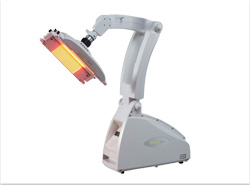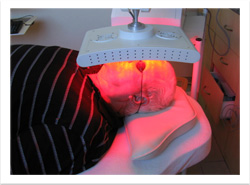SERVICES
- Allergy Screening
- Chemical Peels
- Dermapen
- Facial Skin Analysis
- FreshEyes
- Hyperhidrosis (Excessive Sweating)
- Hair Loss Treatment
- Laser Clinic
- Liquid Facelift
- Keloid Treatments
- Medical Facials
- Medical Treatments
- Mole Mapping
- Photodynamic Therapy (PDT)
- Skincare Advice
- Pigmentation Treatment
- Surgical Procedures
- Ultraviolet Phototherapy
USEFUL LINKS
 PDT is a non-surgical treatment of skin cancer or pre-cancerous lesions. It is also used for acne and skin rejuvenation.
PDT is a non-surgical treatment of skin cancer or pre-cancerous lesions. It is also used for acne and skin rejuvenation.
So you could either have Solar Keratosis or a Basal Cell Carcinoma (BCC) or a Bowens. Solar Keratosis is usually red and scaly and occurs most commonly on the face, the head (in balding men) and the forearms and hands. Initially they come and go but finally they are there all the time. If left untreated +/- 1% of those lesions turn into skin cancer per year — that’s why we treat them! A BCC or Bowen is already skin cancer and BCC’s occur most commonly on the face and back while Bowen’s is usually found on the arms and legs. Skin cancer is the most common form of cancer worldwide and in particular in our country. Almost everybody has had enough sun damage in their lives to develop skin cancer when we get older.
The most common treatment for Solar Keratosis is Liquid Nitrogen (freezing them), while skin cancers are usually removed surgically. This obviously leads to scarring, which can be subtle if well done but never the less as skin cancers are almost always multiple this can be a major cosmetic problem. That is why PDT was developed in Europe. To find a treatment which is equally effective but doesn’t leave you with scars.
 SO HOW DOES IT WORK?
SO HOW DOES IT WORK?
First we apply a cream, which is called “ALA” or Amino-Levulanic acid, a compound related to Bilirubin and Porphyrins (substances produced in your liver). All cells in the body need this compound, but abnormal cells absorb it faster than normal cells. After we apply the cream we cover it with a plastic dressing to allow it to be absorbed. After a period of 1-4 hours we take the dressing off and apply a light, which is visible red light.
This light is a very strong visible red light (635nm). The energy from this light activates the cream and this produces Oxygen radicals. Those radicals destroy all cells that have absorbed the cream — so it destroys abnormal cells but not your normal cells.
Now while those cells get destroyed and died, which is worst during the 12 minutes of treatment. It may be painful — so we may give painkillers ½ hour before the treatment. In the following 24 hours it well feel like a very severe sunburn: the skin will turn red, sometimes swollen, some crusting and oozing can occur if the lesions were deep. In those first 24 hours it may be necessary to take more painkillers. After that the area usually heals within 1-2 weeks. It is important that you keep the area well moisturised all the time and if there is crusting / oozing then you should use Bactroban 2x/day for 3-4 days. The skin will then peel off (like in a sunburn) and heal completely. Although it will be very unsightly for those 1-2 weeks the end results are always good.
PAIN
The pain depends on the amount of sun damage sometimes it is difficult to know beforehand exactly how bad it is going to be. However it is always manageable with analgesics. The reddening — which I seen after the healing — can also take up to 6 weeks sometimes, even months to disappear. Again this is an individual reaction but is never permanent.


PLEASE NOTE: The clearance or cure rate is variable but no treatment can be 100% guaranteed to work. Also, you may require more than 1 session to clear your condition completely.
Patient Testimonials
EXCELLENTTrustindex verifies that the original source of the review is Google. From my first visit with Dr Jhetam I knew I would go back. He is compassionate , friendly and has an interaction which made you feel comfortable. This is very important in any doctor because our relationship with our doctor is very intimate.Posted onTrustindex verifies that the original source of the review is Google. Dr Jhetman is truly one of a kind. Anyone who is fortunate enough to be in his care can so grateful. Academic, informative and reassuring. It’s hard to find a doctor who has this combination of skills these days. He dealt with my Melonoma concerns with swift and professional care. And his staff are equally as competent and caring. I cannot commend Dr Jhetman and his staff enough on true patient care. Thank you!Posted onTrustindex verifies that the original source of the review is Google. I was absolutely satisfied with my experience with Dr Jhetham & his winning team. Keep up the good work.Posted onTrustindex verifies that the original source of the review is Google. Best skin doctor..Dr Jetham prescribed the best products that have brought so much of a glow to my skin..being a transplant patient and so much happening to my skin just 4 visits to him and my face is back to it's radiance ..I hightly reccomend Dr Jetham ...you won't go wrong..Posted onTrustindex verifies that the original source of the review is Google. Dr. Imraan Jhetam and his team provided exceptional care, showcasing professionalism and compassion in every interaction. Dr. Jhetam took the time to thoroughly explain everything, addressing each of my concerns with empathy and understanding. My experience with him was truly wonderful, and I highly appreciate his dedication to patient care.Verified by TrustindexTrustindex verified badge is the Universal Symbol of Trust. Only the greatest companies can get the verified badge who has a review score above 4.5, based on customer reviews over the past 12 months. Read more



